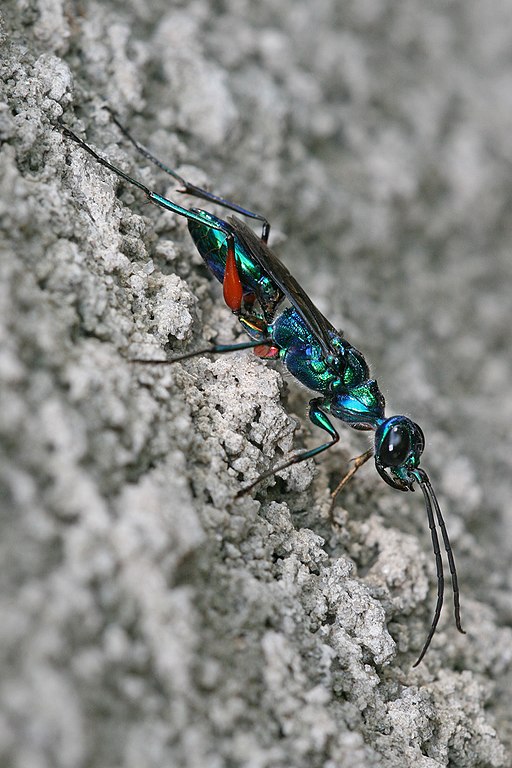Superregnum: Eukaryota
Cladus: Unikonta
Cladus: Opisthokonta
Cladus: Holozoa
Regnum: Animalia
Subregnum: Eumetazoa
Cladus: Bilateria
Cladus: Nephrozoa
Cladus: Protostomia
Cladus: Ecdysozoa
Cladus: Panarthropoda
Phylum: Arthropoda
Subphylum: Hexapoda
Classis: Insecta
Cladus: Dicondylia
Subclassis: Pterygota
Cladus: Metapterygota
Infraclassis: Neoptera
Cladus: Eumetabola
Cladus: Endopterygota
Superordo: Hymenopterida
Ordo: Hymenoptera
Subordo: Apocrita
Superfamilia: Apoidea
Familia: Ampulicidae
Subfamiliae (2): Ampulicinae - Dolichurinae - incertae sedis
[source: Ohl & Spahn (2010)]
Overview of genera (6) [+fossil genera]
Ampulex – Aphelotoma – Dolichurus – Paradolichurus – Riekefella – Trirogma
[source: Catalogue of Life: 2012 Annual Checklist]
Name
Ampulicidae Shuckard, 1840
Ampulex compressa, commonly called Emerald Cockroach Wasp. Pictured in Dar es salaam, Tanzania.
References
Template:Shuckard, 1840
Jahantigh, F., Rakhshani, E., Mokhtari, A. & Ramroodi, S. 2017. Catalogue of Ampulicidae, Crabronidae and Sphecidae of Iran (Hymenoptera, Apoidea). Zootaxa 4307(1): 1–96. DOI: 10.11646/zootaxa.4307.1.1. Reference page.
Ohl, M.; Spahn, P. 2010: A cladistic analysis of the cockroach wasps based on morphological data (Hymenoptera: Ampulicidae). Cladistics, 26: 49–61. DOI: 10.1111/j.1096-0031.2009.00275.x
Riek, E.F. 1955: Australian Ampulicidae (Hymenoptera: Sphecoidea). Australian journal of zoology, 3(1): 131–144. DOI: 10.1071/ZO9550131
Vernacular names
English: Cockroach Wasps
日本語: セナガアナバチ科
The Ampulicidae, or cockroach wasps, are a small (about 170 species), primarily tropical family of sphecoid wasps, all of which use various cockroaches as prey for their larvae. They tend to have elongated jaws, pronounced neck-like constrictions behind the head, strongly petiolate abdomens, and deep grooves on the thorax. Many are quite ant-like in appearance, though some are brilliant metallic blue, green, and hot pink.
Most species sting the roach more than once and in a specific way. The first sting is directed at nerve ganglia in the cockroach's thorax, temporarily paralyzing the victim for a few minutes - more than enough time for the wasp to deliver a second sting. The second sting is directed into a region of the cockroach's brain that controls the escape reflex, among other things.[1] When the cockroach has recovered from the first sting, it makes no attempt to flee. The wasp clips the antenna with its mandibles and drinks some of the haemolymph before walking backwards and dragging the roach by its clipped antenna to steer it to a burrow, where an egg will be laid on it. The wasp larva feeds on the subdued, living cockroach.
Classification
Classification of Ampulicidae follows the Catalog of Sphecidae by Wojciech J. Pulawski, California Academy of Sciences:[2]
Ampulicinae
Ampulicini
Ampulex – 132 species, found worldwide
Trirogma – 7 species from Asia
Dolichurinae
Aphelotomini
Aphelotoma – 8 species from Australia
Riekefella – 1 species from Australia
Dolichurini
Dolichurus – 50 species, found worldwide
Paradolichurus – 4 species from the New World
References
Piper, Ross (2007), Extraordinary Animals: An Encyclopedia of Curious and Unusual Animals, Greenwood Press.
Pulawski, Wojciech. "Catalog of Sphecidae: Family group names and classification" (PDF). California Academy of Sciences. Retrieved 9 January 2020.
Retrieved from "http://en.wikipedia.org/"
All text is available under the terms of the GNU Free Documentation License


